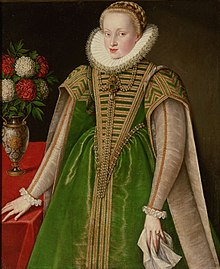Maria Christina, Princess of Transylvania
| Maria Christina of Austria | |
|---|---|
 Portrait of Maria Christina, Princess of Transylvania, ca. 1592. | |
| Princess consort of Transylvania | |
| Tenure | 13 December 1596 – 23 March 1598 20 August 1598 – 21 March 1599 |
| Princess of Transylvania | |
| Reign | 18 April 1598 – 20 August 1598 |
| Born | 10 November 1574 Graz, Duchy of Styria, Holy Roman Empire |
| Died | 6 April 1621 (aged 46) Hall in Tirol, County of Tyrol, Holy Roman Empire |
| Burial | Hall in Tirol, Austria |
| Spouse | Sigismund Báthory |
| House | House of Habsburg |
| Father | Charles II, Archduke of Austria |
| Mother | Maria Anna of Bavaria |
Maria Christina of Austria (10 November 1574 – 6 April 1621), was a Princess of Transylvania by marriage to Sigismund Báthory, and for a period in 1598 elected sovereign Princess regnant of Transylvania.
Life
[edit]She was the daughter of Archduke Charles II of Austria, the son of Emperor Ferdinand I, and Maria Anna of Bavaria. Her elder brother Archduke Ferdinand, succeeded as Holy Roman Emperor in 1619.
Marriage
[edit]On 7 February 1595 was received in Graz the formal petition of marriage between Maria Christina and Sigismund Báthory, ruling Prince of Transylvania, by the nobleman Stephen Bocskay. The marriage contract was negotiated almost a month, and finally the bride on 15 June accompanied by her mother, the Prince-Bishop George of Lavant and 6000 German horsemen. In Kaschau Maria Christina fell ill with fever, which delayed the re-ride.[1] The formal marriage took place in Weissenburg on 6 August 1595, and soon after Maria Christina moved to Transylvania.
Princess consort
[edit]The marriage was regarded as a major political gain, as Sigismund, formerly a vassal of the Ottoman Empire, now formed close ties with the Holy Roman Empire. Emperor Rudolf II appointed Sigismund Prince of the Holy Roman Empire (Reichsfürst),[2] and also secured the possession of Transylvania, if the couple remain without offspring. The agreement was signed on 16 January 1595 by the Hungarian parliament in Bratislava.[3]
However, this union proved to be completely unhappy: Sigismund, after a disastrous wedding night, refused to consummate the marriage and sent his wife to a fortress in Kővárgara, where Maria Christina was kept as prisoner.
Reign
[edit]In 18 April 1598, at the request of the local nobility, she was elected to occupy the Transylvanian throne after her husband abdicated. However, her rule was only nominal because Emperor Rudolf II sent representatives to rule. On 20 August 1598, Sigismund Báthory regained the throne and reconciled with his wife, but sent her again to Kővár.
Later life
[edit]When Sigismund abdicated for a second time in March 1599, Maria Christina finally left him and returned to Austria in April. On 17 August 1599 Pope Clement VIII dissolved her marriage, and in 1607 she joined to her younger sister Eleanor in the Haller Convent (Haller Damenstift) in Hall in Tirol, where she died in 1621, aged forty-six.
Ancestors
[edit]References
[edit]- ^ Johannes Voigt: Geschichte des Deutschen Ritterordens in seinen zwölf Balleien in Deutschland, vol. II, G. Reimer, 1859, p. 281.
- ^ Leopold Hassler: Geschichte des österreichischen Kaiserstaates, I. Klang, 1842, p. 253.
- ^ Johann Sporschil: Die Geschichte der Deutschen von den ältesten Zeiten bis auf unsere Tage, vol. III, G. J. Manz, 1859, p. 209.
- ^ a b Wurzbach, Constantin von, ed. (1860). . Biographisches Lexikon des Kaiserthums Oesterreich [Biographical Encyclopedia of the Austrian Empire] (in German). Vol. 6. p. 352 – via Wikisource.
- ^ a b Wurzbach, Constantin von, ed. (1861). . Biographisches Lexikon des Kaiserthums Oesterreich [Biographical Encyclopedia of the Austrian Empire] (in German). Vol. 7. p. 20 – via Wikisource.
- ^ Ferdinand I, Holy Roman Emperor at the Encyclopædia Britannica
- ^ a b Charles V, Holy Roman Emperor at the Encyclopædia Britannica
- ^ a b Obermayer-Marnach, Eva (1953), "Anna Jagjello", Neue Deutsche Biographie (in German), vol. 1, Berlin: Duncker & Humblot, p. 299; (full text online)
- ^ a b Goetz, Walter (1953), "Albrecht V.", Neue Deutsche Biographie (in German), vol. 1, Berlin: Duncker & Humblot, pp. 158–160; (full text online)
- ^ a b Wurzbach, Constantin von, ed. (1860). . Biographisches Lexikon des Kaiserthums Oesterreich [Biographical Encyclopedia of the Austrian Empire] (in German). Vol. 6. p. 151 – via Wikisource.
- ^ a b Philip I, King of Castile at the Encyclopædia Britannica
- ^ a b Chisholm, Hugh, ed. (1911). . Encyclopædia Britannica. Vol. 15 (11th ed.). Cambridge University Press.
- ^ a b Casimir IV, King of Poland at the Encyclopædia Britannica
- ^ a b Revue de l'Agenais (in French). Vol. 4. Société des sciences, lettres et arts d'Agen. 1877. p. 497.
- ^ a b Riezler, Sigmund Ritter von (1897), "Wilhelm IV.", Allgemeine Deutsche Biographie (in German), vol. 42, Leipzig: Duncker & Humblot, pp. 705–717
- ^ a b Brüning, Rainer (2001), "Philipp I.", Neue Deutsche Biographie (in German), vol. 20, Berlin: Duncker & Humblot, p. 372; (full text online)


 French
French Deutsch
Deutsch